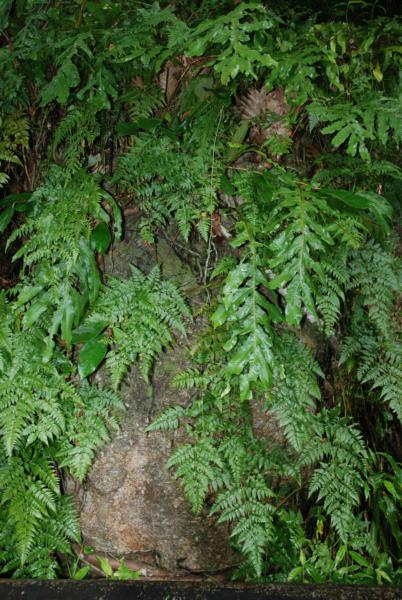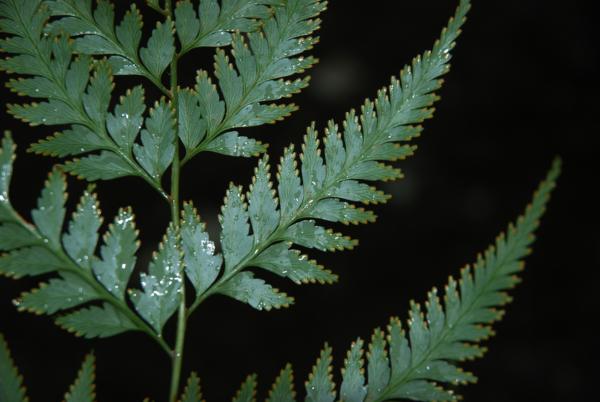
Davallia solida (G.Forst.) Sw.
Family
Davalliaceae
Nomenclature
Davallia solida (G.Forst.) Sw., Schrad. J. Bot. 1800(2): 87. 1801; Christ, Bot. Tidsskr. 24: 110. 1901; C.Chr., Bot. Tidsskr. 32: 345. 1916; E.Smith, J. Siam Soc. Nat. Hist. Suppl. 8: 3. 1929; Tardieu & C.Chr., Fl. Indo-Chine 7(2): 104. 1939; Holttum, Rev. Fl. Malaya ed. 1, 2: 360, f. 207. 1955 [‘1954’]; Holttum, Dansk Bot. Ark. 23: 234. 1965; Seidenf., Nat. Hist. Bull. Siam Soc. 19: 86. 1959; Tagawa & K.Iwats., Acta Phytotax. Geobot. 23: 54. 1968; T.Sen, U.Sen & Holttum, Kew Bull. 27: 226. 1972; Tagawa & K.Iwats., Fl. Thailand 3: 163. 1985; Nooteboom, Fl. Males., Ser. II, Ferns and Fern Allies 3: 263. 1998; Boonkerd & Pollawatn, Pterid. Thailand: 170, 234. 2000. – Trichomanes solidum G.Forst., Fl. Ins. Austr.: 86. 1786. – Type: Forster 308 (BM holo; P), Pacific Islands.
Description
Rhizome long creeping, 6– 12 mm diam., scaly throughout; scales oblong-subtriangular, gradually narrowing towards apex, 4–5 mm long, apical part thin, pale brown, with dense hairs about 1 mm long, caducous, basal portion dark brown to nearly black, imbricate; old portion of rhizome covered by these basal portion of scales up to 3 mm in length. Stipes stramineous or sometimes brown, 9–35 cm long. Lamina subdeltoid, 15–90 x 21–40 cm, tripinnate; lateral pinnae subopposite; all pinnae anadromous; basal pinnae the largest, oblong-subtriangular, with distinct stalk; pinnules stalked, oblong, cuneate at base, gradually narrowing towards acuminate apex; secondary pinnules (ultimate segments) narrowly oblong, sessile, narrowly cuneate at base, moderately acute at apex; axes distinctly grooved, grooves decurrent to each other; veins visible, but not raised; glabrous or with finely branched wooly hairs sparsely scattered beneath and at main junction points. Sori terminal on veinlets, at margin of ultimate segments; involucre cup-shaped, up to 1.5 mm long, about twice as long as wide.
Distribution in Thailand
SOUTH-WESTERN: Phetchaburi; SOUTH-EASTERN: Chanthaburi, Trat; PENINSULAR: Ranong, Surat Thani, Phuket, Nakhon Si Thammarat, Trang, Songkhla, Yala.
Distribution in Cambodia
Kampot, Koh Kong, Kompong Speu
Wider Distribution
Widely known in Malesia and Polynesia, north to Indochina and S China.
Ecology
On tree trunks or on rocks in half-shaded places or in some dense evergreen forests at altitudes below 300 m.
Proposed IUCN Conservation Assessment
Least Concern (LC). This species is widespread and not under any known threat.
Notes
The sterile leaves are less dissected and thus the species is subdimorphic in appearance. The size and form of fronds as well as their dissection are to some extent variable, according to available light and moisture.
Voucher specimens - Thailand
Middleton et al. 4373, Nakhon Si Thammarat, Khao Luang National Park (E).
Voucher specimens - Cambodia
Bouillod 5, Kampot (P); Viboth R3-49, Koh Kong, Thma Baing (P).
Habit (Davallia solida is the the more finely divided plant)
Lower surface of pinnae and sori
Site hosted by the Royal Botanic Garden Edinburgh. Content managed by Stuart Lindsay, Gardens by the Bay, Singapore and David Middleton, Singapore Botanic Gardens. Last updated 24 January 2012

